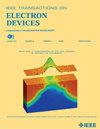伪火花驱动电子束源的击穿特性分析
IF 2.9
2区 工程技术
Q2 ENGINEERING, ELECTRICAL & ELECTRONIC
引用次数: 0
摘要
本文通过实验研究分析了伪火花(PS)放电驱动片状电子束源的击穿特性。我们设计并开发了一种单间隙 PS 驱动片状电子束源。所开发的片状电子束源由空心阴极(HC)和平面阳极组成,片状孔径为7/times 1$毫米,电极间隙为3毫米。实验研究是在 10-20 kV 的不同工作电压和氩气环境下进行的。电子束源在自击穿模式下运行。实验还研究了 PS 放电对 HC 背面的影响。对 HC 表面的击穿前和击穿后条件进行了评估。使用了不同的表征技术,如扫描电子显微镜(SEM)和能量色散 X 射线分析(EDAX)元素分析,以观察 HC 材料成分的变化。本文章由计算机程序翻译,如有差异,请以英文原文为准。
Analysis of Breakdown Characteristics of a Pseudospark-Driven Electron Beam Source
In this article, an experimental investigation has been carried out to analyze the breakdown characteristics of a pseudospark (PS) discharge-driven sheet electron beam source. A single-gap PS-driven sheet beam source has been designed and developed. The developed sheet electron beam source consists of the hollow cathode (HC) and planar anode having a sheet aperture of
$7\times 1$
mm with a 3 mm interelectrode gap. The experimental investigation has been carried out at different operating voltages in the range of 10–20 kV and argon gas environment. The electron beam source has been operated in the self-breakdown mode. Experimental characterization has also been performed to study the effect of PS discharge on the back surface of HC. The prebreakdown and after-breakdown conditions of the surface of HC have been evaluated. Different characterization techniques such as scanning electron microscope (SEM) and energy dispersive X-ray analysis (EDAX) elemental analysis have been used to observe the changes in the material composition of HC.
求助全文
通过发布文献求助,成功后即可免费获取论文全文。
去求助
来源期刊

IEEE Transactions on Electron Devices
工程技术-工程:电子与电气
CiteScore
5.80
自引率
16.10%
发文量
937
审稿时长
3.8 months
期刊介绍:
IEEE Transactions on Electron Devices publishes original and significant contributions relating to the theory, modeling, design, performance and reliability of electron and ion integrated circuit devices and interconnects, involving insulators, metals, organic materials, micro-plasmas, semiconductors, quantum-effect structures, vacuum devices, and emerging materials with applications in bioelectronics, biomedical electronics, computation, communications, displays, microelectromechanics, imaging, micro-actuators, nanoelectronics, optoelectronics, photovoltaics, power ICs and micro-sensors. Tutorial and review papers on these subjects are also published and occasional special issues appear to present a collection of papers which treat particular areas in more depth and breadth.
 求助内容:
求助内容: 应助结果提醒方式:
应助结果提醒方式:


